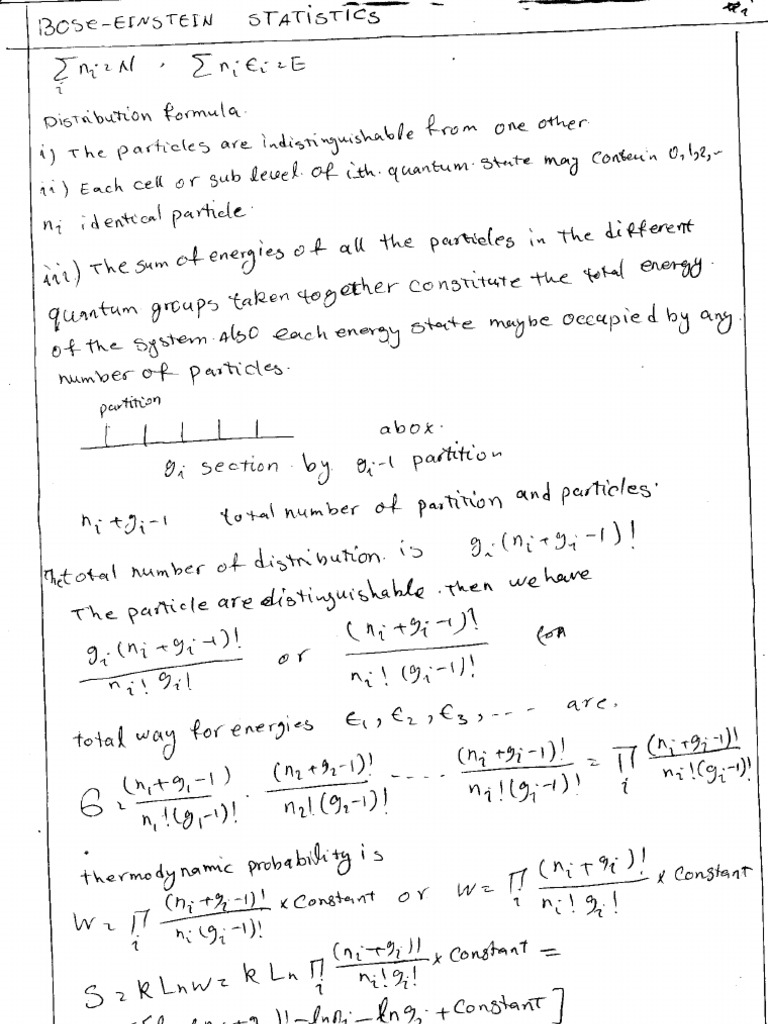The concept of Bose-Einstein statistics, first articulated by Satyendra Nath Bose and Albert Einstein in the early 20th century, revolutionized our understanding of quantum mechanics and thermodynamics. This innovative theoretical framework lays the groundwork for comprehending the behavior of particles at statistical equilibrium, particularly bosons—particles that obey Bose-Einstein statistics. The implications of this theory are vast, giving rise to phenomena that challenge our conventional perceptions of matter. Here, we delve into some notable examples of Bose-Einstein phenomena, illuminating their significance and prompting a reevaluation of classical physics.
One of the most remarkable examples of Bose-Einstein behavior is the formation of Bose-Einstein condensates (BECs). A BEC occurs when a dilute gas of bosons is cooled to near absolute zero, leading to a state where a significant fraction of the particles occupies the lowest quantum state. This phenomenon exemplifies macroscopic quantum effects, as the atoms in a BEC lose their individual identities and behave as a single coherent entity. First experimentally realized in 1995 with rubidium-87 atoms, BECs have opened new avenues in quantum physics and have implications for quantum computing and precision measurement technologies.
Furthermore, the study of superfluidity in liquid helium-4 serves as a poignant illustration of Bose-Einstein dynamics. Below a critical temperature of approximately 2.17 K, helium-4 transitions into a superfluid state, characterized by the complete absence of viscosity. This curious behavior can be attributed to the bosonic nature of helium-4 atoms, which allows for the formation of a coherent ground state. The phenomenon of superfluidity not only defies classical intuition but also unveils the profound implications of quantum mechanics in everyday materials. Exploration of superfluidity also sheds light on the fundamental principles guiding quantum phase transitions—an area of active research with implications spanning condensed matter physics and beyond.
Another compelling example of Bose-Einstein statistics manifests in the phenomenon of laser action. The fundamental principles underlying laser operation are intrinsically connected to the coherence of light emitted by atoms in excited states. When a population of photons is stimulated to occupy the same quantum state through a process called stimulated emission, a coherent beam of light is generated. The laser thus operates as a macroscopic quantum system, where the coherence among bosonic photons leads to the amplification of light. This intersection of quantum physics and optics not only revolutionized communication technologies but also invites deeper inquiry into the quantum nature of light itself.
The field of quantum gases has also witnessed significant advancements, particularly in understanding degenerate Fermi gases juxtaposed against Bose gases. While Fermi-Dirac statistics govern fermionic particles (like electrons), the investigation of mixtures of Bose and Fermi gases can yield intriguing insights into quantum statistical effects. For instance, the behavior of atoms in a Bose-Fermi mixture highlights the interplay between different quantum statistics, leading to unique phenomena such as phase separation and superfluidity. These studies encourage a reevaluation of foundational principles and challenge our understanding of quantum interactions across diverse systems.
A less widely known yet fascinating embodiment of Bose-Einstein phenomena is the concept of quantum vortices. During the transition to a superfluid state, the development of quantized vortices provides visual evidence of the collective quantum behavior embedded in Bose-Einstein systems. Quantum vortices are characterized by a core region devoid of superfluid density, surrounded by circulating superfluid flow. The intricate and stable arrangements of these vortices underscore fundamental principles of topological quantum physics, firmly establishing the interconnectedness of quantum theory and fluid dynamics in both theoretical and experimental realms.
Moreover, the emergence of specific coherent states in BECs and lasers has led to various applications in metrology and precision measurements. Techniques such as atomic clocks and atomic interferometry hinge on the coherence properties arising from quantum statistical effects. These applications extend to practical technologies that underpin navigation systems and global positioning, revealing how theoretical constructs can transition into tangible advancements that reshape modern society. Such overlaps between fundamental research and applied science compel further investigations into the applications of Bose-Einstein principles across diverse domains.
The exploration of Bose-Einstein phenomena is not merely an esoteric pursuit; it offers profound insights that resonate through various fields of science. As researchers unveil new properties of systems exhibiting Bose-Einstein behavior, they challenge existing paradigms. From the theoretical modeling and experimental realization of BECs to the intricate behaviors exhibited by superfluid helium or the applications of lasers, the significance of Bose-Einstein statistics extends beyond the confines of basic research.
In conclusion, the examples highlighted—Bose-Einstein condensates, superfluidity, lasers, and quantum vortices—represent the rich tapestry of phenomena that elucidate the profound implications of Bose-Einstein statistics. These instances knit together concepts of quantum coherence, phase transitions, and ultimately challenge our understanding of ordinary matter and its collective behaviors. The ongoing inquiries into these avenues not only fuel the curiosity of physicists and engineers alike but also hold the potential to redefine the limits of technological advancement, establishing a bridge between the abstract realms of theory and the practicalities of application. As science continues to penetrate deeper into the mysteries of the quantum world, the legacy of Bose and Einstein endures, propelling humanity towards uncharted territories of knowledge.












